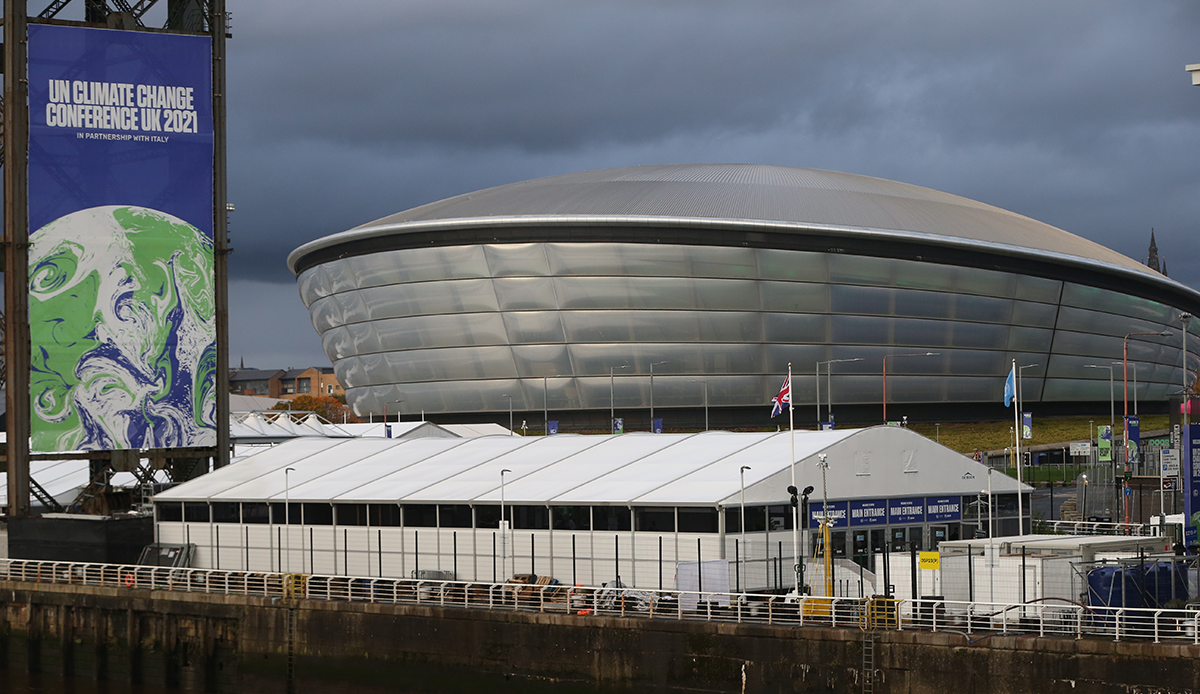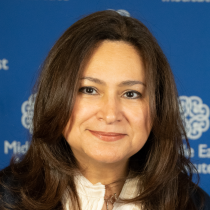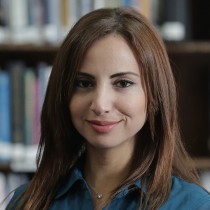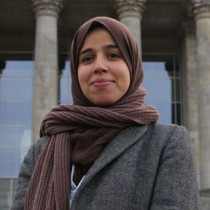

Introduction
As the U.N. Climate Change Conference (COP26) kicks off in Glasgow, climate change is front and center on the global agenda. Few regions of the world have more at stake than the Middle East and North Africa, given the current environmental and sustainability challenges and potential future scenarios. Experts from across MEI weigh in with their thoughts on what should be the key outcomes from COP26.
Photo by Hasan Esen/Anadolu Agency via Getty Images
Viewpoints
-
Mirette F. Mabrouk
Mirette F. Mabrouk

Developed countries need to put their money where their mouths are
When the U.N. Climate Change Conference (COP26) kicked off on Oct. 31, the politics is likely to have been as challenging, if not more so, than the issues of climate change.
It didn’t bode particularly well when Chinese President Xi Jinping and Russian President Vladimir Putin said they wouldn’t attend in person. China and Russia are the world’s highest and fourth highest greenhouse gas emitters respectively, with China alone emitting a jaw-dropping 27% of total global emissions. China is something of an oddity. Despite being the world’s largest producer of renewable energy technology and products, almost 60 % of its energy is produced by coal. Even more distressingly, from a climate change perspective, the country has financed 240 coal-powered plants in Africa and Asia as part of its Belt and Road Initiative, and it’s feared that those plants will produce almost 50% of the world’s carbon emissions by 2050.
Those plants are part of the other political elephant in the room: the demand by developed nations that emerging economies hurry up and clean up their acts by switching immediately to clean energy. To emerging economies, this demand, coming from nations that have been polluting since the Industrial Revolution, and have effectively accounted for half of all carbon emissions, despite being less than a sixth of the planet, smacks of hypocrisy. Last month, the BRICS countries (Brazil, Russia, India, China, and South Africa) lambasted the EU’s Carbon Border Adjustment Mechanism, calling it “discriminatory.” The legislation, signed in July of this year and aiming to come into effect in 2026, effectively taxes the carbon content of goods.
The BRICS nations, however, are relatively wealthy compared with many emerging economies. The latter would presumably be delighted to spare their citizens the health issues caused by pollution, which, in turn, takes a toll on their economies, but they lack the funds to do it. Even worse, many of them are in debt to countries like China, struggling to pay off those coal-powered plants.
There is good news, however, if developed markets are prepared to do something constructive: put their money where their mouths are.
Renewable energy products have become significantly more cost-efficient over the years. The price of solar power modules, for example, has dropped to less than 0.2% of what it was in the mid-1970s. It can make sense for poorer countries to go green, if they have help setting up the technology in the first place. This is where developed countries can come in. Strategic financing for renewable energy in emerging economies is a viable, and vital, step toward getting them to go green. There are, of course, impediments. China, for example, has a vested interest in the debt accrued from coal-powered plants across Africa and Asia and it would require creative thinking to bring it around. However, developed nations, and specifically the U.S. and the EU, need not let that slow down their efforts. There is a large and varied toolbox on hand and many options to help make the transition, among them new renewable energy technology and carbon offset schemes.
If developed nations want emerging markets to go green, then it will not be enough to ask, they will have to actively help them get there. Ultimately, it is in their own interests.
Mirette F. Mabrouk is a senior fellow and founding director of MEI's Egypt Program.
-
Karen E. Young
Karen E. Young

The Gulf oil producers as solution-finders after COP26
There are some very interesting announcements of net-zero emissions targets from the world's largest hydrocarbon producers, as pressure builds to get to some international consensus on climate change action. For oil and gas producers in the Gulf, they must make the case that their business is sound, necessary for stable global economic growth, and also a reliable source of energy that is not 100% clean, but cleaner and greener than other global oil products. The Gulf states, Saudi Arabia and the UAE, will focus on their ability to use existing technologies in carbon capture and storage to better inform and assist in an energy transition both in the Middle East and North Africa (MENA) as well as globally.
Added to that, Saudi Arabia and the UAE can compartmentalize their green economy efforts in ways that make the business case for their own energy transition within national oil companies, to be the owners and powerbrokers of a number of clean and cleaner energy products from natural gas, to solar power, to blue and green hydrogen production. It is possible to leverage experience in the oil and gas sector into an array of energy products, and the Gulf states are especially well-placed to do so. These states may also model how to ramp up electrification in their economies, with massive solar projects and targets for domestic power production that go from about 1% of domestic electricity production from renewables to 50% in just a decade. There is no other experiment like it in the world to invest in renewable power production at this pace and scale.
There is a competition for investment within all energy products, carbon-intensive and non-carbon, and this competition is heightened in the Gulf by a drive for investment into their economies at large, as part of a diversification strategy. A commitment to a net-zero emissions target can include offsets in green initiatives (like tree planting to carbon capture) and certain zones or clean energy projects that are showcases of new technology, as the city of Neom aspires to be. And exports of hydrocarbons do not count as domestic emissions. So, the calculation of a net-zero target has some flexibility.
A net-zero target has a business case behind it. It brands a state hydrocarbon producer in a class of the solution-finders, rather than the obstructionists, even as hydrocarbon production continues ahead. And there are important distinctions in the way oil and gas is produced that gives merit to the investment case for "designer" or "preferred" lower emissions hydrocarbons in the UAE and Saudi Arabia.
But ultimately, the MENA region will need what it always needs: government capacity to reliably deliver public goods at fair prices, namely electricity and preferably electricity produced from low carbon sources. And countries across the Middle East will need access to capital, either through loans, investment partners, or concessional financing, to make that a reality. They will also need to work on the pricing side, to reduce subsidies in both oil and gas exporters and importers, and to gain the trust of citizens that government revenues and spending are in their best interests.
Karen E. Young is a senior fellow and founding director of MEI's Program on Economics and Energy.
-
Jessica Obeid
Jessica Obeid

Major challenges for the Middle East, but also a significant opportunity
The global energy crunch has fueled a heated debate around the impact of increasing reliance on renewable energy in power systems ahead of the U.N. Climate Change Conference (COP26). But technology is advancing and costs are falling, and this presents an opportunity for Middle Eastern countries to avoid pitfalls and leapfrog in the energy transition. Yet, due to financing gaps, the region may witness a growing inequality in access to technology and addressing that is a collective responsibility.
While the world needs to halve its emissions within this decade, the latest climate pledges for 2030 put the planet on track for a temperature increase of at least 2.7℃ this century. Yet, many countries are stepping up, adopting more aggressive targets and committing to reach net zero by the middle of the century.
To achieve this, we need to phase out coal and double down on renewable energy investments and low-carbon technologies. Instead, the opposite is currently happening, the global energy crunch is worsening, and prices are rising. Power outages and system failures are increasingly common around the world, prompting consumers to become more and more worried about the reliability of power supply and invest in backup diesel generators. Utilities are falling back on polluting fossil fuels, gasoil, and coal. Nowhere is this more evident than in China, which was responsible for more than half of the world’s coal-powered generation in 2020, down from 70% a decade earlier. Worryingly, China is now bringing back full-capacity production of some coal mines, which, even if temporary, risks delaying the phase-out targets. The steep drop in wind power production in the U.K. in September has also raised some additional concerns about renewables and the energy transition.
What does all of this mean for the Middle East? Climate change is a threat multiplier and will increase instability and insecurity in the region. Food insecurity, water shortages, drought, extreme climate — the region already witnesses all of them, and they are all interlinked with energy and climate change. Yet, there is a significant opportunity for the Middle East to avoid the pitfalls of countries elsewhere and leapfrog in the energy transition as costs fall. The recent energy crunches are a reminder that the energy transition requires a shift in the way power systems are designed and regulated. The simplistic ways of dealing with conventional power plants and systems do not rise to the complexity of the new energy architecture. One major challenge is that many renewable energy resources do not generate dispatchable electricity and production levels vary by the day or season.
The good news is that the technology is there and it is advancing. Geothermal is a baseload renewable energy generation source with tremendous opportunities, but it is currently lagging. The various energy storage systems and the services they provide to stabilize the grid in addition to storing electricity need to be accounted for. The adoption of these and other technologies may be faster than anticipated and may follow the trends of renewable energy deployment, which had been significantly underestimated. The increase in deployment will drive these costs down, but this would be undermined without energy-efficiency measures to reduce the spiking increases in demand.
However, all of this entails significant financing, and the region has been struggling to attract foreign direct investment, albeit at different levels. Ensuring there is widespread, equal access to technology across the region is a collective responsibility. Addressing this requires minding the finance gap and providing support in developing pipelines of bankable projects to transform pledges into actions. One country falling behind means the entire Middle East could suffer the consequences.
Jessica Obeid is an independent energy policy consultant and a non-resident scholar with MEI’s Lebanon and Economics and Energy programs.
-
Malak Altaeb
Malak Altaeb

Activating the role of developing countries
The convention of the Paris Agreement has divided countries worldwide into two groups, developed and developing, according to their contribution to greenhouse gas emissions. This dichotomy began with the 1992 Kyoto Protocol, which excluded developing countries entirely. Then, in 2016, the Paris Agreement came into force, and at first, it gave the impression of ending the Kyoto Protocol’s dichotomy because it included both developing and developed nations, rich and poor, in tackling climate change.
In fact, however, this dichotomy remains, as article 4 of the Paris Agreement states, “Developed country Parties should continue taking the lead by undertaking economy-wide absolute emission reduction targets.”
This, in turn, shows that developing country parties are included but wholly reliant on developed countries to provide financial support for the implementation of their mitigation and adaptation plans.
In this U.N. Climate Change Conference (COP26), it is very important that the role of developing countries in tackling climate change is recognized. This must be further enhanced and prioritized by identifying the Nationally Determined Contributions (NDCs) of each developing country for the next five years, in addition to positive implementation of the NDCs to reduce their greenhouse gas emissions. This is especially true for developing countries that depend on fossil fuels, i.e. the Gulf states, with a focus on mixed transition.
In addition, it is highly likely that the discussion will revolve around the allocated budget for developing countries. It was pledged to be around $100 billion. However, the money has not yet been fully paid to developing countries.
During COP26, discussions should address a reasonable annual allocation of climate financing for developing countries over a five-year period. This must also include a clear distribution of climate financing contributions from each of the developed country parties.
The unfair distribution of the previous climate finance payments, which were paid mostly in loans, not in grants, was a disadvantage rather than an advantage. Providing financial support in the form of loans would only increase poorer developing countries’ debts and eventually add to their existing problems beyond tackling climate change. Thus, COP26 must address the benefits of providing funding in the form of grants for developing countries and in turn, the benefitting countries must clearly address both their long-term mitigation projects and short-term adaptation plans.
Malak Altaeb is a non-resident scholar with MEI’s Climate and Water Program and an independent consultant, writer, and researcher based in Paris, France.
-
Intissar Fakir
Intissar Fakir

For Morocco, real achievements in renewables, but still plenty of room for improvement
Ahead of the U.N. Climate Change Conference (COP26), Morocco submitted its Nationally Determined Contributions targeting a 45.5% reduction in carbon emissions by 2030. Morocco was present at a pre-COP meeting in Milan, eager to draw attention to its achievements in renewable energy and increasing efforts on climate adaptation. The newly appointed Prime Minister Aziz Akhannouch will represent Morocco in Glasgow together with Leila Benali, the minister of energy transition and sustainable development.
Morocco’s climate action goals are built in part on its significant renewable energy plans and infrastructure. The country has ranked high on the Climate Change Performance Index, including in 2018, when it was rated second largely due to its efforts to develop renewable energy sources. The massive Noor solar energy complex outside of the High Atlas town of Ouarzazate anchors Morocco’s renewable energy infrastructure and ambitions. The kingdom wants to draw greater investment in renewables to meet its promises and lessen its reliance on imports. In addition to these practical goals, this focus on renewable is, for Rabat, also way to cement the country’s reputation as a progressive regional geopolitical player.
Lessening reliance on imported energy is a key economic priority that is driving investment in renewables. Morocco still relies heavily on coal for electricity production — currently coal makes up 38%, oil 8%, and natural gas 18% — but the share of renewable energy has increased as a percentage of total production, reaching 37% in 2020. This is just shy of Morocco’s Paris Agreement goal of 42%. Morocco is projecting the share of renewables in electricity generation to reach 52% by 2030.
In terms of overall energy usage patterns, Morocco still relies heavily on fossil fuels. Oil makes up 60% of its total energy consumption, followed by coal at about 29%, with gas at 3.7%, and renewables (solar, hydro, and wind combined) at 7.9%. This was highlighted by the recent loss of access to Algerian natural gas Morocco had been receiving as part of the Maghreb-Europe Gas Pipeline deal. The deal expired at the end of October as increased tensions between the two geopolitical rivals brought cooperation to a halt. Morocco now faces a temporary need to make up the shortfall in gas supplies. Until the country can reach its higher renewable targets, it is not clear what the short-term plan will be to address this gap. Will Morocco revert to liquefied natural gas — which will require stop-gap regasification facilities or plans — or increase its usage of coal — which goes against its own stated policies and targets? And with an eye toward exporting renewable energy to Europe, including plans to develop green hydrogen that run the risk of aggravating water scarcity issues, it is not clear how the country intends to balance its own domestic needs against its export promises.
Intissar Fakir is a senior fellow and director of MEI’s North Africa and Sahel Program.











